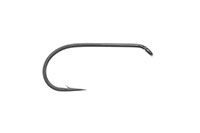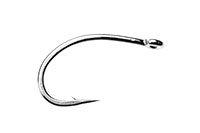
In the Lake MARUNUMA --Vol.20--
Generous Terrestrial
After the first several days of September passed, Marunuma, a small lake in Nikkoh in Japan looked changed. Leaves of trees started turning red. The lake was covered with falling leaves before the morning breeze blew. Branches of trees used to hang over the lake like an umbrella to make shade but now sunbeams streamed through scarce leaves. Consequently, less fish stayed near the bank and less rises occurred. Fish jumped several times only in the morning and the lake became completely quiet after 10 o'clock. Instead rises began to be found in the centre of the lake. At first those rises happened sporadically and at various spots. But as the morning hours went by, rises occurred more often and the area was limited, too. I watched those rises while I was rowing around near the bank. Then I could not wait any more. I started rowing towards the centre of the lake.
A brown trout appeared from under the layer of ice. Its silver body was shining. In the end of April Marunuma was still covered with snow and ice.
Rises occurred most frequently near the dam site. Since that area was as far as several ten metres away from the bank, there was no hiding place or any other advantage for fish. I did not believe that many fish were staying there but wondered why rises occurred so often. When I came near to the frequent rise spot another rise occurred just beside my boat. Does the fish play or eat? If it eats something, what is it? I looked around the water surface. A small lump was floating 10m ahead. The moment I gazed hard to know what it was it disappeared together with the rise. The fish is eating something special!
After 11 o'clock breezes started crossing the lake. It had been utterly quiet without a ripple but now insects fell from the sky a little at a time. Those insects scattered on the water in front of me were bright-coloured stinkbugs. Some were green or yellow and some have got a subdued brown back and a bright orange belly. As soon as those insects fell on the water noticeable rises occurred around my boat. Rainbow trout eat stinkbugs! I stood up at once and extended the line to prepare for the next rise.

A male brown trout with winter colour. My fly was Fiesta, a monster killer of the Lake Motosu in Japan. Dry fly season had not come yet.
Hitting Rises as if Hitting Moles' Pop-up Heads
There were a lot of rises around my boat but not a just right spot for me. It occurred where I had never expected. I had nothing to do because I could not predict where the next rise would occur. For example, I cast the fly to a rise about 20m ahead in good timing. Then there was another rise less than 5m ahead of me and immediately I retrieved the line. In that way I could not know the rhythm of rises. But before I caught 3 trout I got the hang of it. Fish were swimming around here, seeking after stinkbugs. Their speed was rather higher than those fish cruising near the bank that I had fished before. I cast the fly after I found the rise but I had to do so very quickly. It was ideal to make the fly floating on the target spot within 3 seconds and the maximum time was 5 seconds.
Predicting the next rise spot was one of the great pleasures of dry fly fishing in Marunuma.

Green Pepper is not easy to find when it is placed in the shade but this fly has always got a stable response from fish.
I devised a fishing method. My tactics are to limit my territory and to neglect any rise outside it. My territory is inside an angle of 45 degrees each to right and left from the line floating in front of me. The distance of my territory is within 20m. I set the same territory behind me, too. If I extend the line as far as 10m and keep it floating on the water I will be able to set the fly within 3 seconds to the rise that occurs inside my territory. If a rise occurs near my floating fly I will pick up the line and cast the fly by the first forward cast. I mean I will make wet fly cast. If a rise occurs more than 15m apart I will make false cast only once.
Some of you must think it to be strange that I set my territory even behind me. If there is a rise behind me I will cast my fly by back cast as far as the distance permits. Actually, when a rise occurred in a convenient spot for me I could cast the fly at incredibly high speed. Because I look back and cast the fly, I hook the fish as if I made forward cast. I enjoyed that very much.
Every time the wind blew some stinkbugs fell and were scattered on the water. Probably stinkbugs lived on all the surrounding mountains but many of them fell on this area because the wind blew through here.

Those dry flies were born as an imaginary stinkbug and other imaginary terrestrial insects. They performed very well in Marunuma.

Tabasco, my original fly, is as effective as hot Mexican chili sauce. Its imaginary shape came from a red or green chili but it also looked like a colourful stinkbug. It performed very well when I hit rises as if I had hit moles' pop-up heads.
After 2 o'clock in the afternoon the rise suddenly decreased. There was no stinkbug on the water, either. My luxurious time of hitting rises as if hitting moles' pop-up heads was over. That fishing pattern was repeated until the end of October. That means I made it my rule that I aimed at the fish staying near the bank in the morning and the evening as I was rowing near the bank whereas I aimed at the rise that occurred in the centre of the lake during the day. Such frequent rises as I could hit as if hitting moles' pop-up heads occurred only in limited hours, at most 2 hours. That meant I spent much longer time in fishing near the bank but, to the contrary, my catches were much fewer there. It was not uncommon that I caught over 80% of my fish by hitting rises.
Rainbow trout were very aggressive when they made a rise to get stinkbugs. They had fierce attacks on my fly. Nevertheless it was not unusual that they returned just in front of the fly and the fly was swaying on the water surface. Then I made several new flies before my second time fishing by such a style as hitting rises. All of them came from the image of colouful stinkbugs. Green Pepper and Tabasco were special favourites of rainbow trout.
-- To be continued --
- NET SHOP INFORMATION

SL6 Black Spey Hooks

DU3 Limerick Spinner Hooks

SL4 Single Bartleet Hooks

XD1 Tube Fly Double Hooks

DD2 Flat Perfect Hooks

DD1 Black Terrestrial Hooks

TD4 Old Limerick Wet Hooks

DU1 Silver May Hooks

MU1 Flat Midge Hooks

LD3 Long Limerick Hooks

TD2 Summer Sproat Hooks

XS1 Tube Single Silver Hooks

TD6 Siver Sedge Hooks

SL5 Black Spey Hooks

DU3 Limerick Spinner Hooks
- TROPHY CLUB
- FLY SHOW
- EXHIBITION
- MASTERS`
- FLY DRESSING CONTEST Archives
- TRAVELLER Archives
- TACKLE IMPRESSIONS Archives
- ANGLERS` PHOTO GALLERY Archives
- ----------------------------------------------
- トロフィークラブ
- フライショー
- エキシビション
- マスターズ
- フライドレッシング・コンテスト・アーカイヴ
- トラヴェラー・アーカイヴ
- タックル・インプレッション・アーカイヴ
- アングラーズ・フォトギャラリー・アーカイヴ
株式会社サワダ 185-0021 東京都国分寺市南町3-13-4
SAWADA'S INC. 3-13-4 Minamicho, Kokubunji, Tokyo 185-0021, Japan
写真・ドキュメントの無断転載を禁じます。
All the images and documents found on this site are owned by Ken Sawada and may not be used without permission.
But, link to this site is FREE.
Copyright © 2000 - 2025 SAWADA'S INC.. All rights reserved.
SAWADA'S INC. 3-13-4 Minamicho, Kokubunji, Tokyo 185-0021, Japan
写真・ドキュメントの無断転載を禁じます。
All the images and documents found on this site are owned by Ken Sawada and may not be used without permission.
But, link to this site is FREE.
Copyright © 2000 - 2025 SAWADA'S INC.. All rights reserved.
